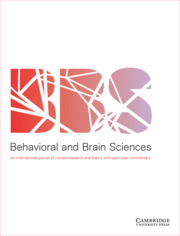No CrossRef data available.
Article contents
Do boundaries matter so much for societies?
Published online by Cambridge University Press: 03 April 2025
Abstract
Moffett's definition of society is broadly applicable to all group-living animals from insects to nation states. Presenting examples from primates, I illustrate difficulties in defining boundaries between societies and even what societies defend to demonstrate the complexity of using an understanding of the processes effecting primate societies to understand those effecting human societies. However, finding similarities and differences in processes shaping societies is intriguing and Moffett's definition provides an excellent starting point.
Information
- Type
- Open Peer Commentary
- Information
- Copyright
- Copyright © The Author(s), 2025. Published by Cambridge University Press
References
Abd Hair Awang, J. S., Bakar, N. R. A., Abdullah, M. Y., & Liu, O. P. (2013). Informal cross-border trade Sarawak (Malaysia)-Kalimantan (Indonesia): A catalyst for border community's development. Asian Social Science, 9(4), 167–173.Google Scholar
Brown, J. L., & Orians, G. H. (1970). Spacing patterns in mobile animals. Annual Review of Ecology and Systematics, 1(1), 239–262.CrossRefGoogle Scholar
Golub, S. (2015). Informal cross-border trade and smuggling in Africa Handbook on trade and development (pp. 179–209). Edward Elgar Publishing.Google Scholar
Green, E. (2012). On the size and shape of African states. International Studies Quarterly, 56(2), 229–244.Google Scholar
Harris, T. R., & Chapman, C. A. (2007). Variation in diet and ranging of black and white colobus monkeys in Kibale National Park, Uganda. Primates, 48, 208–221.Google ScholarPubMed
Kalbitzer, U., Golooba, M., & Chapman, C. A. (2023). Site fidelity and home range shifts in a leaf-eating primate. In Reyna-Hurtado, R., Melletti, M. & Chapman, C. A. (Eds.), Movement ecology of Afrotropical forest mammals (pp. 99–113). Springer.CrossRefGoogle Scholar
Morrison, R. E., Dunn, J. C., Illera, G., Walsh, P. D., & Bermejo, M. (2020a). Western gorilla space use suggests territoriality. Scientific Reports, 10(1), 3692.CrossRefGoogle ScholarPubMed
Morrison, R. E., Hirwa, J. P., Mucyo, J. P. S., Stoinski, T. S., Vecellio, V., & Eckardt, W. (2020b). Inter-group relationships influence territorial defence in mountain gorillas. Journal of Animal Ecology, 89(12), 2852–2862.Google ScholarPubMed
Seiler, N., & Robbins, M. M. (2020). Using long-term ranging patterns to assess within-group and between-group competition in wild mountain gorillas. BMC Ecology, 20, 1–13.Google ScholarPubMed
Titeca, K. (2020). Informal cross-border trade along the Uganda-DRC Border. Borderland Policy Series 2 (pp. 1–21). University of Antwerp.Google Scholar
WorldEconomicForum. (2021). How has the European map evolved over time? Retrieved May 26, 2024, 2024, from https://www.weforum.org/agenda/2021/11/european-map-has-changed-over-2-400-years-history/Google Scholar



Target article
What is a society? Building an interdisciplinary perspective and why that's important
Related commentaries (24)
A nation by any other name: A failure to focus on function
Belonging to a community of moral values as a key criterion of society
Beyond biology: A sociological stance on what is society
Collective memories and understandings of human societies
Definitions and cultural dynamics in understanding “societies”
Do boundaries matter so much for societies?
Group identity without social interactions?
How an interdisciplinary study of societies can develop a comprehensive understanding of the function of deceptive behavior
Identity groups, perceived group continuity, and schism
Identity is probably too complicated to serve as a useful criterion for defining society
Multi-species societies
Philosophy or science of societies?
Psychological mechanisms for individual recognition- and anonymous-societies in humans and other animals
Revisiting the spaces of societies and the cooperation that sustains them
Societal inferences from the physical world
Societies have functions for individuals and collectives
Societies of the open ocean without territories
Societies, identities, and macrodemes
Society: An anthropological perspective
The family as the primary social group
Understanding the jaggedness in social complexity is more important
Vocalizations are ideal identity signals
What is a society in the case of multilevel societies?
Why societies are important and grow so large: Tribes, nations, and teams
Author response
A society as a clearly membered, enduring, territory-holding group